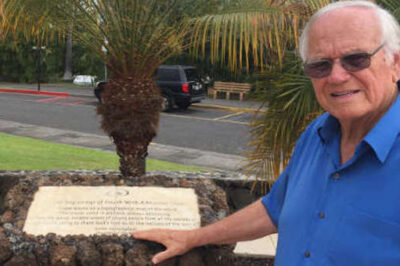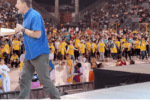As Christians, we believe the power of Christ is sufficient to change lives and cultures.
A great example of this is in the Hawaiian Islands, where missionaries first landed in 1820. The Hawaiians were a warlike people, constantly fighting each other on the various islands. And they made many human sacrifices to appease the goddess of the constantly erupting volcano.
Within a couple of decades, the king of Hawaii had become a Christian and with him, the entire Hawaiian population. The missionaries created an alphabet and translated the Bible into the language of the people. Within 25 years, this illiterate society had a literacy rate of 75 percent, far above many more “advanced” countries of the world during that era.
And instead of being warlike, the Hawaiians became the gentle people we associate with the lovely aloha spirit.
I learned this on a recent trip to Kona, Hawaii, on the Big Island. I had the privilege of meeting with Loren Cunningham, the founder of Youth With a Mission (YWAM), which is headquartered there, along with the University of the Nations. Listen to my podcast with Cunningham, who says he believes great revival is coming.
When Loren met me at the dock while my cruise ship was in port, he showed me a historical marker put up by the local ministerial association that calls the spot the Plymouth Rock of Hawaii. Here, 23 missionaries landed at a place that had been prophesied by one of the local tribal leaders.
Today, I recorded a podcast about this in which I go into much more depth. Please listen to and share it.
The historical marker in the above photo is much more detailed than I can be here, so I’ve typed it below for those of you who are history buffs like I am.
Let’s praise God for the change in the Hawaiian Islands where, I was told, churches outnumber bars four to one. And let’s be thankful for this silent witness at Kona telling tourists and others the mighty things God has done.
THE PLYMOUTH ROCK OF HAWAI’I
Kailua-Kona pier covers most of the lava outcropping here on Kai-a-ke-akua (Sea of God) Bay. A vestige is still visible on the north edge. On April 4, 1820, American Protestant missionaries aboard the 85-foot brig Thaddeus landed on this site where Kahuna Nui (high priest) Hewahewa had prophesied the new God would land. Today this site is known as the Plymouth Rock of Hawai’i.
In 1808, two native Hawaiian boys left this island and were educated at the Foreign Missions School in Cornwall, Connecticut. They became accomplished scholars and also sincere followers of Jesus Christ. As they prayed together, they felt they were to return to share the message of God’s Word with their countrymen. They were known as Henry Opukaha’ia and Thomas Hopu.
After Opukaha’ia’s untimely death in 1818, his journal was published. It inspired 23 Americans and Hawaiians in New England, including Thomas Hopu, to bring education and the gospel to the Hawaiian islands.
On arrival in Hawai’i, the missionaries stepped onto the exact place Hewahewa had prophesied. Liholiho (Kamehameha II) and co-regent Ka’ahumanu gave permission for the missionaries to stay to establish schools and churches. The people welcomed them with aloha and Liholiho gave them a home and a royal canoe shed, which they used as the first house of worship. With the help of Hawaiian teachers, they created a written language and finished a complete translation of the Bible by 1839.
In 25 years, the literacy rate of Hawai’i was one of the highest in the world. Ships called “Morning Stars” carrying native Hawaiian missionaries sailed to the Pacific Islands and Oregon with the message of Christ.
“A great God, a mighty God, a living God, an everlasting God is Jehovah … a rainbow standing in the sea is Jesus our Redeemer…” —Hewahewa
UA MAU KE EA O KA AINA I KA PONO
“The Life of the land is perpetuated in righteousness.” —King Kauikeaouli (Kamehamena III)
This sign is a gift from the Kona Ministers Fellowship and the Christian churches of Hawai’i. {eoa}







Leave a Comment
You must be logged in to post a comment.